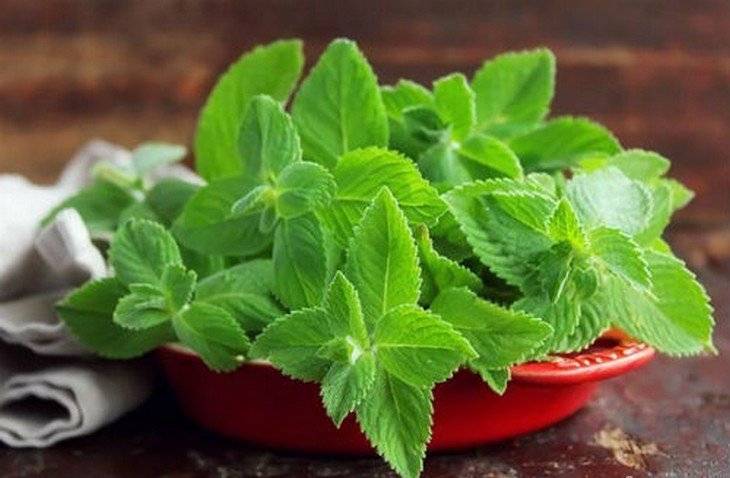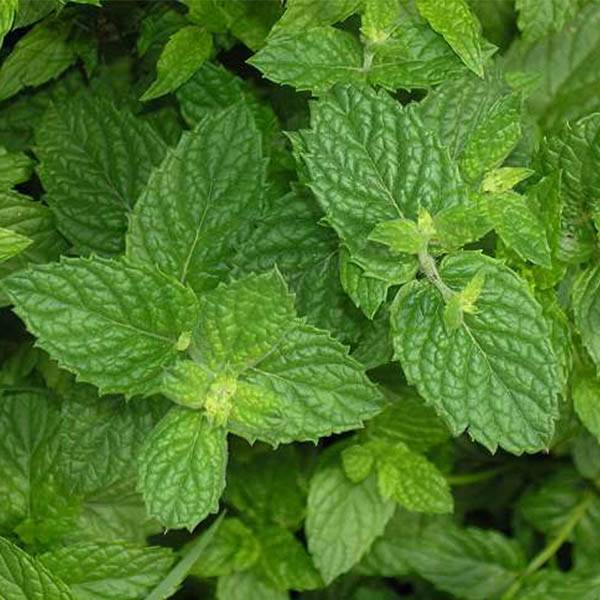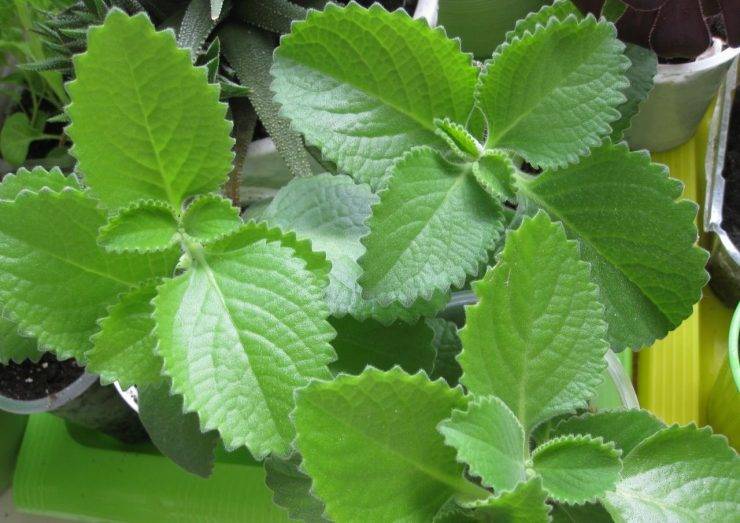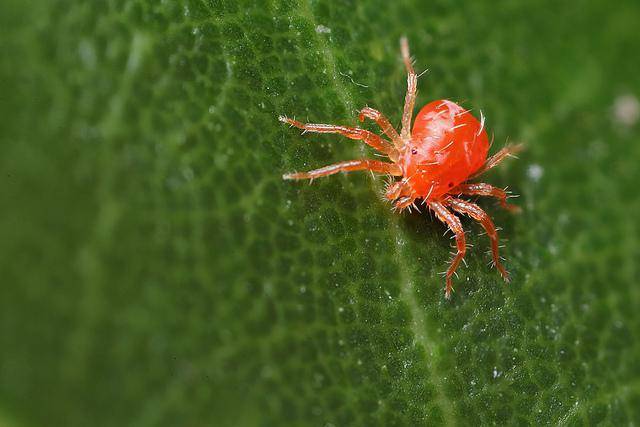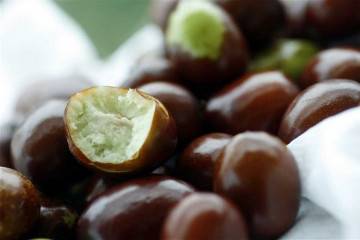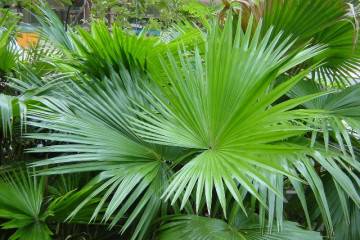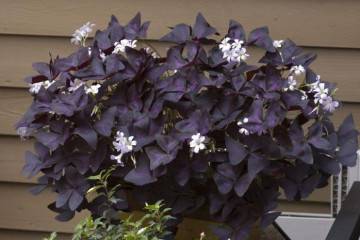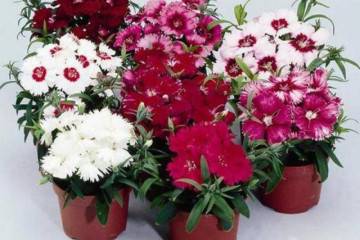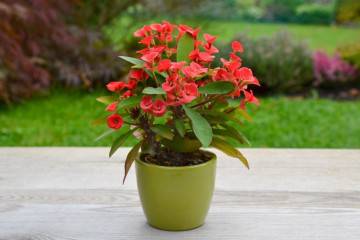Indoor mint - how to plant and care
Content:
Indoor mint is an evergreen shrub that emits a pleasant scent. The plant is considered unpretentious. It is required to follow several rules of care for indoor mint to grow and multiply at home. It will not only become a decoration of the windowsill, but also, thanks to its healing properties, will help to overcome a number of ailments.
Indoor mint or plectrantus plant
Indoor mint with thick, fleshy leaves is popular with flower growers. She is known for her non-capricious character. And if you touch the leaves, you can easily feel the aroma of menthol.
A short description of what it looks like
Indoor mint is an ornamental plant, the height of which does not exceed 40 centimeters. Leaves densely cover thin shoots. They are distinguished by their small size and oval shape. Small denticles are clearly visible along the edge of each leaf. It is they who make the plant attractive. Leaves are glossy, matte, solid or with a border around the edges.
Useful and harmful properties
Mint owes its name "molar tree" to its ability to repel moths, mosquitoes and flies. Insects dislike the scent of a room dweller, so they immediately leave the house.
In addition, plectrantus, the so-called flower that smells of mint, is known as a remedy:
- The smell has a beneficial effect on the nervous system, normalizes sleep.
- Baths with plant leaves have healing properties - they relieve enuresis.
- Dry leaves are mixed with a powder and applied to the skin of babies in diaper rash areas, and mashed fresh ones are applied to mosquito bites to relieve itching.
It is believed that indoor mint can relieve asthma attacks and relieve nasal congestion. To do this, you just need to chew the fragrant leaves. And if you add them as a seasoning to meat dishes, you get a new, slightly piquant taste.
You can brew fragrant tea with the leaves of an indoor flower. It is not only tasty, but also beneficial, has a calming effect. It is advised to use it for respiratory diseases.
You should be careful when eating the leaves, especially for children under 12 years old. An allergic reaction may occur due to individual intolerance. This applies, first of all, to people prone to skin rashes. The essential oils found in the bush can lead to dermatitis.
Pregnant and lactating women are advised to refrain from using the plant. It is not recommended to add to food and drink aromatic tea for people with high acidity of the stomach.
How to get out of the homemade mint variety
Different varieties of mint differ in appearance. They have long been loved by flower growers around the world, growing in their backyards and in apartments. Easy care and a lot of useful properties make you pay attention to the evergreen flower.
Curly mint
Curly mint is a perennial plant, its leaves are wide at the cutting, pointed towards the end. The surface is wrinkled. Inflorescences are formed in bundles, one above the other. The flowers themselves are a delicate purple or lilac shade.
The main difference of the variety is that the plant is practically devoid of menthol. But it contains carvone and linalool. Substances are known for use in the food industry, perfumery. For example, carvone, found in essential oils, is found in chewing gum, and linalool is a component in soap fragrances.
Apple mint
Apple mint is a short shrub with velvety leaves. They are green with a white coating. This is ampel mint, so the terraces are decorated with flower pots, hanging pots around the perimeter of the territory.
Field mint
Field mint has large elliptical-shaped leaves. They grow up to 5 centimeters in length, have denticles at the edges, and sharpen at the ends. The flowers are small, pink-lilac. It differs from other varieties in shaggy stems. They can be green or reddish in color. Meadow mint essential oil contains a lot of menthol and terpenes, a substance mainly found in resins.
Long-leaved
Long-leaved mint leaves are up to 15 centimeters long. They are green with a grayish tint, fluffy on the back. The stems can grow up to 1.5 meters in height. Small flowers, lilac or purple. In addition to essential oil, the plant contains vitamin C and tannins.
Care rules
In order for decorative mint to grow and develop at home, it is necessary to choose the optimal place and provide the plant with high-quality soil. To create comfort, you need to monitor the watering and humidity in the room.
Illumination and temperature
Homemade mint in a pot likes bright lighting, but it should be protected from direct sunlight. Otherwise, a burn will appear on the leaves. The plant does not like drafts, so it is better to put it away from the window. In winter, additional lighting is required. The plant does not need to bask in the sun all day, 8-9 hours is enough.
Watering rules and humidity
You need to water the mint tree a lot, but only after the top layer of the soil has dried. In summer and spring, the flower requires more abundant moisture. You can spray the soil in the pot, making sure that it does not wash out. Leaves are not recommended to additionally moisturize to avoid diseases. In winter, the frequency of watering is halved. It is important not to allow the soil to dry out completely, this will lead to the death of the flower.
Indoor mint prefers high humidity. To create it, a pot with a plant is placed in moistened expanded clay. When it dries, it is rehydrated again. The main thing is to ensure that water does not enter the pot through the holes in the bottom.
Top dressing and soil quality
You can feed the plant no more than 2 times a month in spring and summer. This is the time when mint grows and develops most intensively, so additional nutrients will not interfere. In this case, you need to alternate organic and mineral fertilizers. Mixtures prepared for indoor plants are suitable.
The soil should be of low to medium acidity and be sufficiently loose. Use potting soil, adding peat and sand. Also, the finished mixture is replaced with turf, humus and leafy soil.Again, baking powder and sand are required. The ingredients are mixed in equal proportions.
Transfer
After purchase, the flower is recommended to be transplanted. The operation must be repeated every year until the plant is 5 years old. Then it is advised to transplant indoor shrubs every 2-3 years.
It is better to carry out the procedure in early spring, before a period of active growth. Procedure:
- Prepare a pot a couple of centimeters larger than the previous one.
- Moisten the turf and garden compost soil.
- Water the plant in advance so that you can easily get it out of the pot without damaging the roots. It is not necessary to destroy the earth lump.
- Pour expanded clay at the bottom of the new pot, a layer of 2-3 centimeters is enough.
- Insert the flower into a container, cover with earth, avoiding voids.
- Water abundantly.
Crown care and pruning
The plant especially requires care with active growth, this is summer-spring. Pinch the mint to maintain the splendor of the bush and, accordingly, an attractive appearance. If the shoots are stiff, they get rid of them so that the plant does not waste energy on their restoration. After pinching and pruning, young shoots immediately appear on the bush.
Propagation of room mint by cuttings
After pruning, carried out in early spring, cuttings remain - material for propagation. It is advised to leave several internodes on the shoots, removing the lower leaves. Cuttings can be placed in a glass of water or immersed in moist soil.
Roots will appear in a maximum of 7 days. You can plant young plants in a couple of weeks when they get stronger. Usually at this time, the roots reach a length of 3 centimeters. Drainage is placed in the pot, the shoot is inserted and covered with moistened earth. They begin to take care of them like an adult plant.
Growing problems, diseases and pests
If the watering regime is not followed, the roots of the plant can rot, which will affect its appearance. Leaves will begin to fade, fall off, change color. In order to prevent waterlogging, it is advised to use drainage, it will exclude the possibility of liquid stagnation at the roots.
If the leaves become pale, they will lose their bright color, it is possible that the flower has been in the sun for a long time. It is worth rearranging it in a place where the light will be diffused. But, keep in mind that the plant does not like the shadow.
Pests and diseases that can harm roommint:
- Powdery mildew. Grayish or black spots are clearly visible on the leaves. To cure the plant, you need to spray it with a solution of serum in water;
- Spider mites, aphids, scale insects. Insects settle on the leaves and then infect the stem and root. It is easy to get rid of pests by wiping the flower leaves with soapy water.
The homemade mint-scented flower or plectrantus is a popular ornamental plant. When properly cared for, it is a neat evergreen shrub.
The main thing is to provide the flower with warmth and timely watering. Then no diseases and pests are terrible for the plant. In addition to its attractive appearance, indoor mint is famous for its medicinal properties and is capable of repelling insects.
